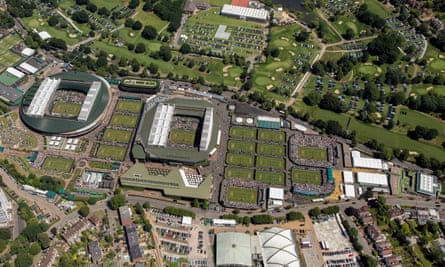Next week, an important event will occur at Wimbledon as the All England Lawn Tennis Club faces opposition from a local council regarding their proposal to construct a stadium with 8,000 seats in a park that is classified as a Grade II* historic site.
On Tuesday evening, the AELTC will make an effort to persuade Wandsworth’s planning committee to approve their plan for constructing a 10-story show court and 38 additional grass courts in Wimbledon Park. Some activists have criticized the proposal, labeling it as an “industrial tennis complex.”
Last month, the 155-year-old club achieved success in gaining approval from Merton’s planning committee. However, a small portion of the park falls under Wandsworth’s jurisdiction. The AELTC needs consent from both councils and the mayor of London (and potentially Michael Gove, the secretary of state for levelling up, housing, and communities) to proceed with the project.
On Monday, planning officers in Wandsworth advised councillors to reject the proposed development due to its potential to greatly impact the openness of metropolitan open land. In a detailed 123-page report, the officers stated that they do not agree with the club’s assertion that there are exceptional circumstances that justify the construction, which would significantly increase the size of the tennis championship grounds from 17 hectares (42 acres) to 46 hectares.
The All England club maintains that it is crucial to expand and enhance its amenities in order to secure the status of Wimbledon as the top tennis tournament in the world.
The 10-member planning committee for Wandsworth will convene at the borough’s town hall on Tuesday evening to cast their vote on the proposal. Local and environmental activists are expected to gather in protest at the meeting. A similar meeting was held by Merton last month, which was disrupted by demonstrators who declared the council chamber a “climate crime scene” and lasted until nearly midnight.
The proposed developments have sparked discontent among the nearby community and environmental organizations. They believe that the park should remain untouched. A petition titled “Preserve Wimbledon Park” has gathered over 14,000 signatures, and the councils have received over 2,000 letters of protest.

The All England club’s construction plans have sparked controversy, as they would require the removal of nearly 300 trees. Local residents have criticized this move as “corporate ecocide”. In response, the club has stated that the majority of these trees are of low quality and has committed to planting 1,500 new trees.
Fleur Anderson, the Member of Parliament for Putney under the Labour party, expressed that Wimbledon Park is considered a protected area and is listed as Grade II* metropolitan open land. This designation requires that any proposed development must have exceptional reasons to be approved. The planning officers of Wandsworth council have not found such reasons and have advised against the plans. The effort to preserve our valuable green space will persist, but this decision is a promising advancement in the right direction.
A representative for the All England club expressed shock at the recommendation from planning officers at the London borough of Wandsworth to reject the AELTC Wimbledon Park project. This comes after the London borough of Merton had approved the application after thorough review and discussion in both their officers’ report and the planning committee.
We apologize that the officers from Wandsworth have a differing opinion, but ultimately it is up to the councillors on the planning applications committee to make their own decision during the meeting on November 21.
The organization stated that a minimum of seven newly planned grass courts will be open to the public for two months after the tournament. Additionally, they plan to offer 500 tickets for Merton and Wandsworth residents to purchase at the proposed new Parkland stadium.
Bypass the advertisement for the newsletter.
after newsletter promotion
The Merton councillor Paul Kohler, who is the Liberal Democrat parliamentary candidate for Wimbledon, described the club’s plans as “an industrial tennis complex – comprising a 10-storey stadium, more than 9km [5.5 miles] of roads, 10 further outbuildings and 38 tennis courts”.
In 1993, the AELTC acquired the freehold of Wimbledon Park for £5.2m from Merton council with the intention of expanding. However, they agreed to a covenant that restricted the use of the land to leisure, recreation, or as an open space.
Kohler has urged Merton to take action in enforcing the covenants. According to Kohler, these covenants were put in place to prevent any development on this valuable piece of open land in the city, and allowed the All England club to purchase the land at a lower price.
The club leased the property to Wimbledon Park Golf Club until 2018. During this time, the chair expressed concern that the SW19 championships would not be able to keep up with its competitors in New York, Paris, and Melbourne if it did not grow and provide better amenities for players and viewers. The most logical solution, according to the chair, was to expand onto the golf club’s grounds.
The lease for the golf club’s land was in effect until 2041, meaning the AELTC was unable to reclaim the land for another 23 years. In exchange for relinquishing their club early, the tennis club offered the golf club members a total of £65 million. This resulted in a windfall of £85,000 for each member, including notable figures such as Piers Morgan, Ant McPartlin, Declan Donnelly, and Gus O’Donnell, the former cabinet secretary.


